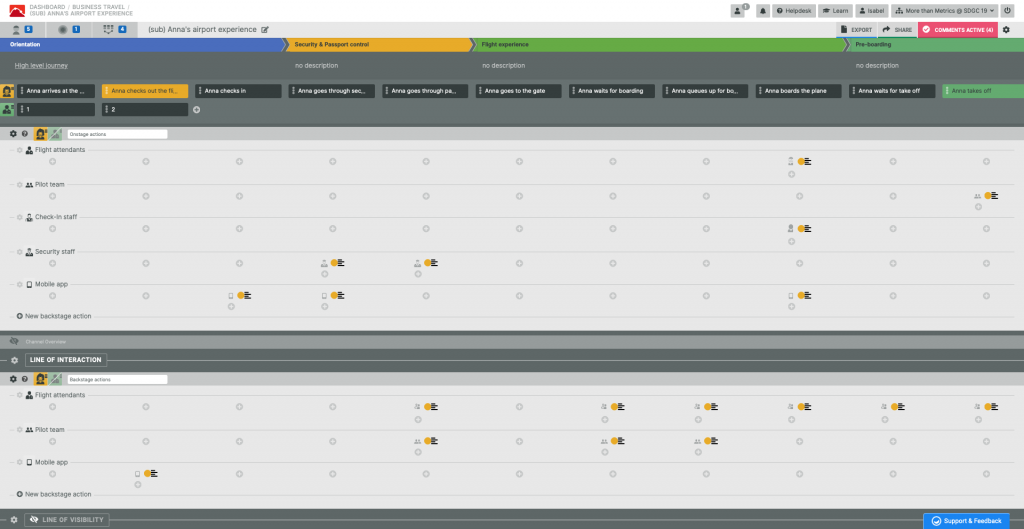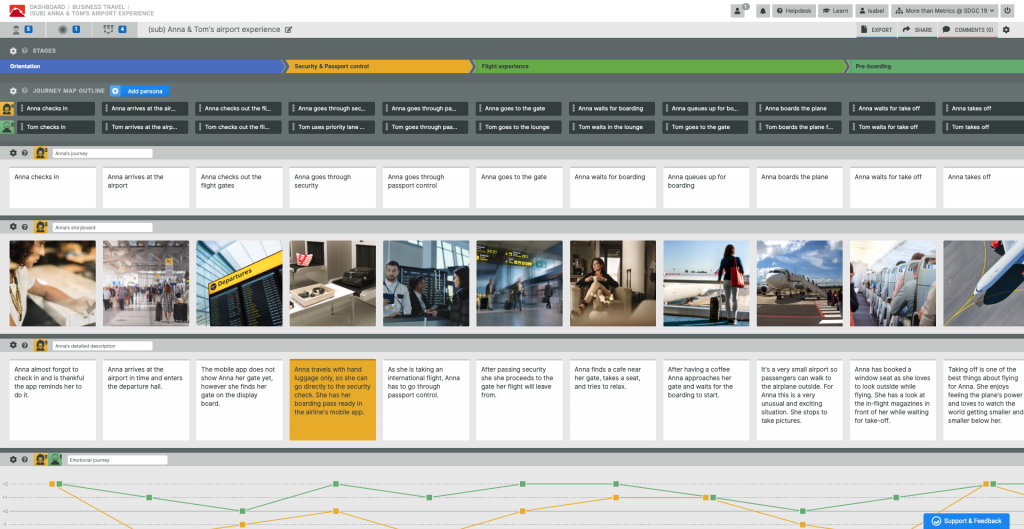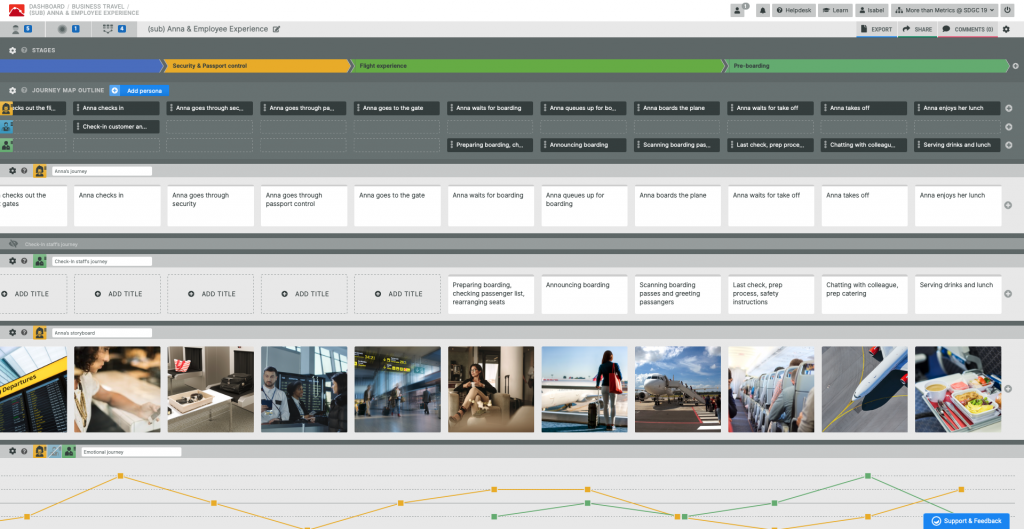Ask Marc – about personas on journey maps
In this session we talked about how to use multiple personas on one journey map to compare their experience. Also we included stakeholder groups into the discussion and learn how backstage activities and service blueprints are connected to personas.
This series was initiated as a place for you to learn more about service design and journey mapping software. Our co-founder Marc Stickdorn and the Smaply team share their experience on how to embed and scale service design in organizations. The sessions usually kick off with a short introduction to the focus topic to bring everybody to the same page, followed by your questions and deep discussions of best practice examples.
On this page you find the recording as well as the transcript. Additionally, the session is available on Spotify, iTunes and Google Podcasts.
Overview
- [03:28] How many personas are too many? Can you get too granular?
- [06:15] What kind of persona is useful for developing a TV channel and how do you use personas in a media project?
- [11:18] How can you use a journey map to best show how different personas meet or interact with each other?
- [17:15] How do you work with complex maps where you have loads of stakeholders?
- [21:22] Is there one-on-one mapping between personas and the organization stakeholders?
- [23:50] When does it make sense to have multiple personas on one map, versus one journey map per persona?
- [25:53] How do you rate the emotional side?
How many personas are too many and can you get too granular?
Yes, you can get too granular.
In the last webinar we showed the connection between personas and customer segments and customer groups. We differentiate between core personas that kind of represent the core segments of your users or your customers, and additional personas that you can use to visualize edge cases and extreme cases.
The core idea of personas is to create empathy.
We’ve always followed the saying in service design “Design for the average, test with extremes”. That means we design towards an average user, a persona representing a core segment you’re designing for. Whatever you design, you test it against edge cases, against extremes.
If you want to roll out personas across an organization and make sure that people start talking about your personas, about your customers as if they were your friends – like: this works for Tom, but I’m not sure if it works for Isabel – then you shouldn’t have too many. I’d say like seven to nine. Because as soon as you have more, it’s hard to remember them.
However, these are only the core personas. You can have way more edge cases. They obviously change from project to project as well. When we talk about the granularity, at some point you will have too many, then you won’t remember them. If you go into the edge cases, at some point they’re gonna start repeating. It’s the same as in a qualitative research where we always talk about theoretical saturation. How much research do we need until we don’t learn anything new anymore?
The same with personas – if you basically covered the main differentiators between behavior patterns that you see, then it doesn’t make sense to add personas to it because they start repeating. And then you actually achieve something called “persona saturation”, like you have everything you need. That’s where you should stop.
What kind of persona is useful for developing a TV channel and how do you use personas in a media project?
A user of us is designing personas for a multi-platform multi-channel science web TV for a festival. She has two types of audiences that will collect user data to build their personas: one is online, and one is audience analysis of cultural organizations. She’s wondering what kind of persona is useful for developing the sort of web TV channel and how do you use personas in a media project like this? Is it useful to define some sort of a learning persona. So tagging off of those company-wide personas versus persona specific for your project.
That’s possible. When we talk about organization-wide personas, that’s a very high maturity level. That’s often something we’re working towards to, but that’s certainly not where you start. Very often you start on a project level. Often when we start creating personas, we start with assumption based personas. We don’t have all the data yet, but we use these personas to collect, summarize and synthesize our data.
Over time we want to develop our assumption based personas into research based personas.
What kind of personas you need depends on your research data. Whatever your research type, the data will tell you about the different behavior patterns. One way to to create personas is doing research on journey maps, instead of personas. If you try to understand how different people experience something like a web TV, or a specific show on it, you can add different layers of data, like an emotional journey or a dramatic arc to visualize the engagement.
If you do that on a per-person basis, you’re going to see patterns on that, hence you’re going to see that people have different journeys. Sometimes it is that way that defines your persona, based on behavior patterns, based on differences you see in your journey map. What some people like, others might not like. Then it’s your decision where you want to focus on – you can’t have everything perfect for everyone. But it’s your decision to tailor it to the audience that you actually strive to have.
Years ago I gave a workshop in Sydney, Australia. There was a participant who had a radio show. For him it was a wild guess attend my workshop. He had no clue what it means. They said “service design for a radio show, that could be useful”. He said he started using personas, he started designing his show with a journey map approach – and it turned out to be extremely successful. He was actually able to double his audience with these tools.
Coming back to the comment about the “Design for the average and tests with extremes” and back to the question about defining a learning persona.
I worked on a project where the focus was on learning; it was on onboarding and bringing new people in. We chose to focus our personas and journey maps on the people who were very invested in the brand because the people that know the brand intimately can tell best what works really well and what doesn’t, what frustrates them. We can use that knowledge to build something that helps us bring these other people in.
How do we help people learn this new thing? Let’s learn from people who have done it already and see what we can leverage from there.
How can you use a journey map to best show how different personas meet or interact with each other?
Let’s use the example of an airline. What you see on the next image is our persona Anna, who travels by using an airplane. That is the high-level map showing everything from the need to travel, booking, preparing, going to the airport, flying, and so on. Very often on this high-level you actually don’t differentiate that much between personas because it’s like the customer lifecycle – a rather abstract thing. But as soon as you zoom in it makes sense to differentiate between personas.

We’re gonna zoom into the moment at the airport and start with Anna. The next image is the sub-journey at the airport, hence everything from arriving at the airport: checking in, going through the security check, passport control, boarding the plane, flying, leaving, enjoying lunch. What we see here is one persona and the steps of that customer journey.

Now you have different ways to bring in more roles, more personas. For example, add a second actor to the journey map: not as a fully blown out persona, but as a stakeholder.
You can use a dedicated lane for backstage processes to show how other people backstage or front stage are involved in this process. We have everything from flight attendants, check-in staff, security staff and so on. As shown on the illustration below, on a journey map you can visualize kind of a summarized service blueprint.
What are the processes, what are the interactions that Anna, our customer persona, has with all the employees that are involved, with all the stakeholders here?

There’s a difference between personas and stakeholders.
In Smaply we differentiate between personas and stakeholders because sometimes, for example for the backstage processes, it doesn’t make sense to have a fully blown out persona with all the details. Then it’s good enough to say who is it and what the interaction with the customer is. That is a stakeholder.
If you then focus on a project for a certain stakeholder, let’s say check-in staff or the flight attendants, you can create an employee journey where you slip into the shoes of your flight attendant and visualize the process. How does it look like from their perspective?
If you only want to show what the interactions are, an approach like this is good enough. It shows where you have the different stakeholders and you visualize where the interactions are, what kind of interactions there are, which channels are used to interact, etc.
A hint for Smaply users: you have the option to add multiple activity lanes. Maybe arrange by importance, have the most important ones in one lane and less important ones in another lane. Then you can simply hide it; everything you hide is not included in your export. By hiding and showing lanes you can tailor your journey map to the audience you’re speaking to. Another example is one lane for the rather technical backstage processes – who do you need to make sure that the plane leaves on time? Or one lane that focuses rather on the interaction side with customers? Depending on what you’re working on, you can then hide or show different lanes.
How do you work with complex maps where you have loads of stakeholders?
Put everything on one map but then tailor it to the audience. Hide those lanes which are not relevant for it.
Up until now we had the situation: one persona, multiple stakeholders. Switching from one persona to multiple personas can be useful in different cases.
What we see on the image below is one journey map with two customer journeys on it, which means we have two customers. We have Anna and we have Tom. You can use that to compare different experiences.

In this example, Tom is the business traveler. Tom has a slightly different experience: it’s much more convenient for Tom to go through the process. Priority boarding, lounge access, stuff like that. His emotional journey is higher than the one from Anna. You can use this to compare different experiences, to understand pain points of different customer groups, of different segments.
It’s also interesting to see how two personas interact with each other.
I was working with a tourism provider who had different products for different customer segments – but they’ve all used the same shuttle bus from the airport to the different hotels. On the shuttle bus they were talking to each other and comparing prices. It was a horrible experience because they started their holiday with knowing that there is someone in a five-star hotel paying less than you in your three-star hotel – just because they booked a little bit earlier. It’s a horrible start of a holiday. By visualizing and connecting the different customer journeys on one map, this became very obvious.
The second use case is the combination of customers, users and employees. What you see here is again Anna’s journey through the airport. I upgraded check-in staff and the flight attendants from stakeholders to personas. You see immediately in the outline where they interact with each other. The map has become a combination of employee journey and customer journey.

In this example it is the the flight experience: when you actually board your plane and take-off. The moment of take-off is often a rather stressful moment for the customer. However, it’s a rather relaxed moment for the flight attendant because they’re very used to it. It is their 10 minutes of calm where they can chat with a colleague, where they don’t have much to do. For them it’s a positive moment, whereas for travelers rather a stressful, less positive moment.
You can compare the emotional journeys with each other, where you see what is positive for your employee but is actually rather negative for your customers.
You can compare these journeys and sometimes you see that the stress level of employees actually has an impact on the experience of customers.
Is there one-on-one mapping between personas and the organization stakeholders?
Imagine the following situation: you compare a customer journey with an employee journey. Let’s make it concrete – your phone is broken and you bring your phone to the shop. You have two journeys: the customer come into the shop, passes on the phone; the employee takes on the phone, starts checking the phone.
What is the customer doing while you’re checking the phone? It’s not a blank spot in your journey, it’s actually waiting time. Then it depends very much on how long this waiting time is. Is this satisfactory, does it takes just a few minutes? Or does it take an hour?
Sometimes the employee journey starts later. How does this relate to the process of the customer, if your dominant story is a story of the customer? Sometimes you actually want to show what the employee is doing at the same time. Then you have this step-by-step one-on-one structure for journey map.
Waiting time or gaps in your journey highlight opportunities for conversation.
What’s happening here, how long is this taking, can we do something better? Especially if it’s waiting time or lack-of-engagement-time. Is this an opportunity we can leverage to do something for this persona, or for our customer? Something that’s going to increase the satisfaction and engagement? The gaps are almost as important as the steps.
When does it make sense to have multiple personas on one map and when does it make sense to have one journey map per persona?
It’s a question of what you aim for and what the goal of your journey map is. Do you want to visualize the experience of one person and then design towards changing this experience? Then probably you have one dominant journey of your customer. You only show the processes, the one the organization needs to do in order to be able to deliver this experience. If you also want to focus on your employee experience, it makes sense to combine them and actually visualize the internal processes as journeys. That is something that is useful in basically any service design project.
You need to focus on employee experience! You need happy employees to create an awesome customer experience.
It’s essential to not only understand the process part, but also what’s happening on an emotional perspective.
I worked with a hotel company who mapped out the experiences of their employees. One of their biggest problems was that employees jumped between tasks all the time. It makes sense to visualize this because this is their reality.
If you look at the process map it looks like this: process A; process B; steps of the processes. But the reality is that employees jump between processes all the time and in between they handle their customers. There it actually really makes sense to visualize the entire pre-experience as well.
How do you rate the emotional side? Is there a scoring system in use here to place on the emotional scale?
In the example that I showed we used a very simple five-point Likert scale, which means
- minus two (very negative)
- minus one (negative)
- zero (indifferent)
- plus one (positive)
- plus two (very positive).
It depends a bit on your organization, what you use and how you structure your research. The five-point Likert scale is one of the most used approaches for that, but some use a seven-point scale, and others use emoticons – so less the rating but rather why you feel in a certain way. There are different approaches for this.
The five-point Likert scale lets you quantify data, which is helpful because at some point you need to take decisions and they should be based on data.
If you’re able to quantify data – for example, by going through a journey with many customers and using the same scale – it makes your journey map much stronger.
A simple way to do that is a contextual workshop. For example, we were working in a ski resort where we actually built out a high-level journey map. We gave out hot chocolate and hot wine to people. They joined us for 10 minutes and talked us through their journey and rated their experiences from positive to negative on a five-point scale. On just one day we collected hundreds of journeys and emotional journeys, which then helped us to quantify that and actually have solid data. This research made the the journey map much stronger.
And now, what's next?
Read about the basics of personas, including how to create one, or check out the other Ask Marc sessions about different topics of human-centric work, like stakeholder mapping, creating CX insight repositories, and many more.










